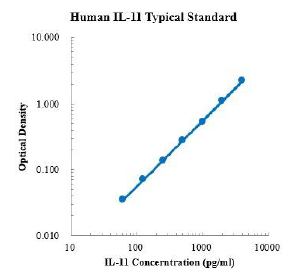| Description | Testing Principle:
This kit uses double antibody sandwich ELISA.Specific anti-human IL-11 capture antibody is prepackaged on a high affinity conjugate plate. The standard substance, the sample to be tested and the detection antibody labeled with biotin were successively added into the HRP-plate well. After full oscillation and mixing, the IL-11 in the sample was placed at room temperature for a 2-hour incubation process. The IL-11 in the sample was combined with the solid phase antibody and the detection antibody. After washing thoroughly to remove free and unbound ingredients, horseradish peroxidase labeled streptavidin-HRP (SA-HRP) is added. After washing again, TMB color substrate was added and incubated in dark at room temperature for color development. The depth of the color reaction was positively correlated with the concentration of IL-11 in the sample. The termination solution was added to terminate the reaction, and the absorbance value was measured at 450 nm detection wavelength (correction wavelength 570-630 nm) using a microplate analyzer. Detection type:Double sandwich enzyme immunoassay Form: pre-coated 96-well plate Sample type: Cell culture supernatant, Serum, Plasma Sample quantity:100 μl Kit composition:pre-coated 96-well plate,Standards,IL-11 test antibody, Standard Diluent, Test Buffer, TMB Color Substrate, Washing Solution, Stop Solution, SA-HRP, Seal Plate Mask, and Instructions . Sensitivity:5.01 pg/mL Detection range:62.5-4000 pg/mL Recovery rate: 84-118% Storage:2-8℃ The standard curve:  Background:
Interleukin 11 (IL-11) is a pluripotent cytokine that was isolated from bone marrow mesenchymal stem cells as early as 1990. It is a member of the IL-6 cytokine family and can be distinguished according to the co-receptor they use, gp130. IL-11 plays an important regulatory role in hematopoietic regulation, especially in stimulating the maturation of megakaryocytes. Studies have shown that IL-11 can improve chemotherapy-induced laminopenia, induce acute phase protein, regulate antigen-antibody response, and participate in the regulation of proliferation and differentiation of bone cells. IL-11 causes bone resorption and also stimulates the growth of certain lymphocytes and, in a mouse model, increases the thickness and strength of the long bone cortex. As a signaling molecule, IL-11 has a variety of functions, including placental formation and to some extent decidualization, and plays a role in the implantation of blastocysts into the endometrium. IL-11, which is made using recombinant DNA technology and is marketed as Oprexil interleukin, is used to prevent severe thrombocytopenia in cancer patients. |





